Cloisonne
掐丝珐琅制作工艺PPT课件
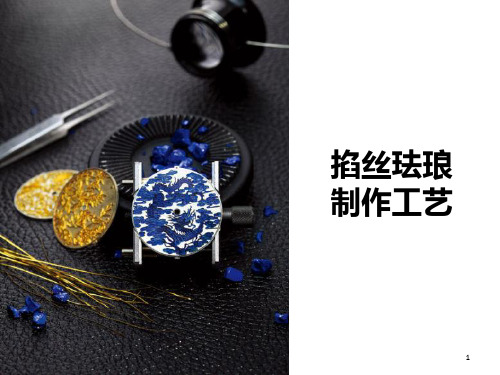
TIPS 色彩决定价格
• 珐琅的颜色来自天然矿物的色彩,其熔点不同,烧制方法、烧制顺序 都会不同,且必须牢记的一点是:黑色和乳白色的珐琅颜色最难烧制, 价格也更贵。
• 因为珐琅烧制的表盘,不可能完全纯净与光滑(如果有,就是一些以 树脂或高科技手段制作的“假”珐琅),而在其他颜色中,这些珐琅 烧制过程产生的细小“砂眼”与孔洞,只有借助放大镜才能看到。
.
15
• 采用“大明火”烧制珐琅,其温度高达850至900摄氏度,由此才可确保珐琅材料的
纯净以及持久的生命力。
• 烧制珐琅必须在真空炉内完成,无论瑞士还是中国,珐琅工艺所用的炉子都这么大,
意味着不可能大批量生产。
• 首先从熔点高的釉料开始烧制,一定要按照熔点高低先后次序,不能有一丝差错。
烧制时间的掌握也非常重要,即使是经验最老道的珐琅技师都无法确切告诉您每次烧
掐丝珐琅 制作工艺
.
1
珐琅工艺
珐琅是在苛刻标准下的极端工艺,更是色彩在温度中的一场探险游戏。
珐琅制品由于是纯手工,具有不可. 复制性,拥有就是惟一的一件。
2
• 自古埃及文明以来,珐琅就一直被视为高贵的装饰品。因为它有着类 似玻璃的原料本质,拥有特殊的美感,不仅令彩绘器物的外观光滑细 致,而且还带有氤氲华丽的色彩。
.
12
用特制的焊药粉进行焊接。这一步 至关终归要,因为使用的金丝只有 0.03毫米,用我们日常使用的打火 机的火就能将金丝烧至溶化。如果 掌握不好焊接的温度,就会使整个 盘面的图案毁坏,甚至将金丝完全 烧没,这一步的成功率只有50%。
.
13
最终精确地将金属丝固定于既定位置
.
14
珐琅原料必须先以玛瑙研钵磨制为极 为精细的粉末,然后以蒸馏水完全浸 湿后才算是可用的珐琅涂料。复杂的 图案要用几十种釉料。
景泰蓝 漆器 英文

• Third, enamels filling – after covering the model with patterns of filigree and rearranging the filigrees, enamels are painted into the partitions of the filigrees. After fusing the powdery glaze with a heat of 800 degrees centigrade (1472 F), it is taken out and the process is repeated three or four times until the surface becomes smooth.
Lacquerware
• Lacquerware are objects decoratively covered with lacquer. The lacquer is sometimes inlaid or carved. Lacquerware includes boxes, tableware, buttons and even coffins painted with lacquer in cultures mostly in the Eastern Hemisphere
• Second, filigree nipping – nipping and patching the thin brass wires into delicate patterns, and then pasting them on to the model to form different partitions, finally heating it to 900 degrees centigrade (1652 F) to weld the patterns firmly to the model
四级翻译练习:中国结+

中国结(Chinese knot)是中国文化的典型代表之一。
中国结源于古代,当时人们用系结的方式来记事,在唐宋时期(theTang and Song Dynasties)逐渐发展成为一种饰品,并在明清时期(the Ming and Qing Dynasties)开始盛行至今。
中国结象征着团结、友谊、和平、热情和爱情等。
制作中国结的材料多种多样,如棉线、丝编、尼龙(nylon)、皮革,甚至是一些贵重金属。
如今,中国结在世界各地广受欢迎。
Chinese knot is one of the typical symbols of Chinese culture.It appeared in ancient times when people tied knots to keep records.It developed gradually as a type of decoration during the Tang and Song Dynasties,and prevailed from the Ming and Qing Dynasties up to now.Chinese knot means reunion, friendship, peace, warmth, and love, etc.Materials used to make the knots are various, such as cotton, silk, nylon, leather andeven precious metals.Today, Chinese knot is popular in many parts of the world.聘金(endowment)是中国传统习俗的一部分。
通常,新郎(bridegroom)需要给新娘家一笔钱作为聃礼来定下婚礼。
但是近几年来其标准不断上升,致使大多数家庭都很难达到。
快速上涨的生活成本是聘金增加的主要原因。
中国陶艺英语
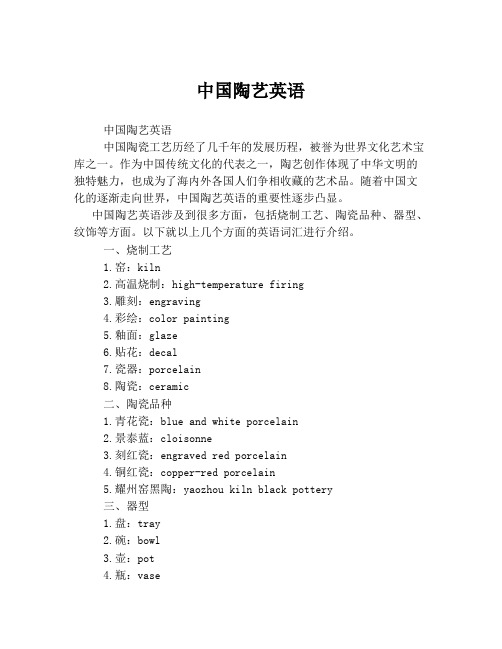
中国陶艺英语中国陶艺英语中国陶瓷工艺历经了几千年的发展历程,被誉为世界文化艺术宝库之一。
作为中国传统文化的代表之一,陶艺创作体现了中华文明的独特魅力,也成为了海内外各国人们争相收藏的艺术品。
随着中国文化的逐渐走向世界,中国陶艺英语的重要性逐步凸显。
中国陶艺英语涉及到很多方面,包括烧制工艺、陶瓷品种、器型、纹饰等方面。
以下就以上几个方面的英语词汇进行介绍。
一、烧制工艺1.窑:kiln2.高温烧制:high-temperature firing3.雕刻:engraving4.彩绘:color painting5.釉面:glaze6.贴花:decal7.瓷器:porcelain8.陶瓷:ceramic二、陶瓷品种1.青花瓷:blue and white porcelain2.景泰蓝:cloisonne3.刻红瓷:engraved red porcelain4.铜红瓷:copper-red porcelain5.耀州窑黑陶:yaozhou kiln black pottery三、器型1.盘:tray2.碗:bowl3.壶:pot4.瓶:vase5.罐:jar6.盏:cup7.鼎:ding四、纹饰1.龙纹:dragons2.凤纹:phoenixes3.花卉纹:flower patterns4.山水纹:landscape patterns作为一门艺术形式,陶艺的英语教育一方面可以帮助学习者更好地了解和认识中国传统文化和艺术,另一方面也有助于中国陶瓷文化与国际陶瓷交流与合作,为中国陶瓷行业开拓国际市场提供技术和交流平台。
除此之外,随着旅游业的发展和人们对中国文化的兴趣不断增强,对外宣传和英语导游也成为了当前中国陶艺英语的重要领域。
拥有陶艺英语技能的人才能在国外向游客介绍中国陶瓷文化,吸引外国游客的情况下将更好地推动中国陶瓷文化的国际化发展。
综上所述,中国陶艺英语不仅可以推动陶瓷文化的发展,也是对于中华文化的一次重要传承和突出展示。
景泰蓝英文介绍

• Lacquer including tianshui lacquer, yangzhou inlaid lacquer ,Pingyao push light lacquer ,Boyang lacquer, Yichun changed lacquer, A Lacquerware Painter with Gold Color,etc. • 漆器包括天水漆器、扬州镶嵌漆器、平遥推光漆器、波阳 漆器、宜春脱胎漆器、描金漆器等。
• 目前的品种主要包括景泰蓝和花丝景泰 蓝两大类,其中景泰蓝产品又分为金地 景泰蓝和蓝地景泰蓝两部分,花丝景泰 蓝又分为金地花丝、银地花丝和蓝地花 丝三类。
•
•
Cloisonne is an important variety of metal crafts in China.景泰蓝是我国金 属工艺品中的重要品种。 All the process of making cloisonné are by hand, are following steps: design, padding making, thread weaving, drawing, burning, polishing and gilding ect."景泰蓝"完全由手工制 成,制作过程十分精细,需要经过制胎、 掐丝、烧焊、点蓝、烧蓝、磨光、镀金 等十余道工序。
Yichun changed lacquer
• Yichun changed lacquer , type beautiful, light and exquisite, colour and lustre is bright, bright as a mirror. • 宜春脱胎漆器造 型美观, 轻巧玲珑,色泽明丽,光 亮如镜。
掐丝珐琅制作工艺
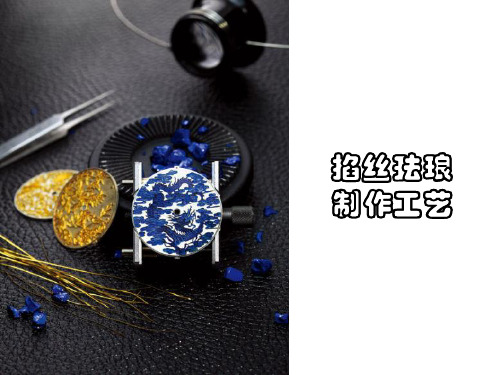
最终精确地将金属丝固定于既定位置
珐琅原料必须先以玛瑙研钵磨制为极 为精细的粉末, 为精细的粉末,然后以蒸馏水完全浸 湿后才算是可用的珐琅涂料。 湿后才算是可用的珐琅涂料。复杂的 图案要用几十种釉料。 图案要用几十种釉料。
• 采用“大明火”烧制珐琅,其温度高达850至900摄氏度,由此才可确保珐琅材料的 采用“大明火”烧制珐琅,其温度高达850 900摄氏度 850至 摄氏度, 纯净以及持久的生命力。 纯净以及持久的生命力。 • 烧制珐琅必须在真空炉内完成,无论瑞士还是中国,珐琅工艺所用的炉子都这么大, 烧制珐琅必须在真空炉内完成,无论瑞士还是中国,珐琅工艺所用的炉子都这么大, 意味着不可能大批量生产。 意味着不可能大批量生产。 • 首先从熔点高的釉料开始烧制,一定要按照熔点高低先后次序,不能有一丝差错。 首先从熔点高的釉料开始烧制,一定要按照熔点高低先后次序,不能有一丝差错。 烧制时间的掌握也非常重要, 烧制时间的掌握也非常重要,即使是经验最老道的珐琅技师都无法确切告诉您每次烧 出来的颜色,因此必须凭经验,详细记录每个颜色所需的配色,烧制时间以及温度。 出来的颜色,因此必须凭经验,详细记录每个颜色所需的配色,烧制时间以及温度。 • 同一个颜色在烧了数次之后竟变成完全不同的颜色,这是经常遇到的事情。有时, 同一个颜色在烧了数次之后竟变成完全不同的颜色,这是经常遇到的事情。有时, 因为原料不稳定,还会导致盘面烧坏。 因为原料不稳定,还会导致盘面烧坏。 • 每上一次颜色就必须烧一次,只要出现失误,所有努力将付之东流。经过反复30多 每上一次颜色就必须烧一次,只要出现失误,所有努力将付之东流。经过反复30 30多 次的烧结,才能呈现丰富完美的色彩。烧制过程中一旦有某个釉料出现裂纹, 次的烧结,才能呈现丰富完美的色彩。烧制过程中一旦有某个釉料出现裂纹,则整只 表盘报废。 表盘报废。
2019年12月四六级翻译预测

2019 年 12 月四六级翻译预测一、传统文化类话题1.扇子在中国,扇子的使用始于数千年前。
扇子是由许多不同的材料制成的。
汉、唐期间,农业有了发展,丝绸和缎面( satin)扇子开始出现,并在文人雅士( scholars and artists )中成为了一种时尚。
他们通过在扇面上书写和绘画来展示自己的才能。
扇子很快获得了非常大的社会意义。
它们成为了有学问的人标准夏季着装的一部分。
中国制作的扇子多种多样。
它们如今依旧享有盛誉。
参考译文: Fans began to be used in China thousands of years ago. They were made out of many different materials. During the Han and Tang Dynasties, due to progress in agriculture, silk and satin fans appeared, and they became a fashion among scholars and artists who showed their genius by writing and painting on the fans. Fans soon acquired considerable social significance. They became a part of the standard summer costume among the learned. A great variety of fans have been produced in China and they still enjoy great reputation today.2.筷子筷子( chopsticks )是中国传统的独具特色的进食工具( dining utensils ),至今已有数千年的历史。
英语人教新目标九年级全一册Section B 2unit5名师课

examples?
Paper cutting has been around for over
1,500 years. Paper cutting sounds very easy but it can be difficult to do.Theppaasspievre, vuosuicaelly red,
Beauty in Common Things
Para1: AIgs iet anbeourtagelneral EachidnifitfnertrroeonddtupcuatircotntoioforCnhina has its own
special formspoefctirfaicdditeiotanialsl anrtd. These usually try to show the tehxinamgsptlheas?t are important in life, such as love, beauty and family. The most common things, from paper to clay to bamboo, are turned into objects of beauty.
beauty.
Байду номын сангаас
Some examples and details of
Chinese traditional art.
Traditional Materials
art form
used
Symbols
sky lanterns bamboo and happiness and
paper
good wishes
3.Paper cutting is usually made of color paper .
Cloisonne
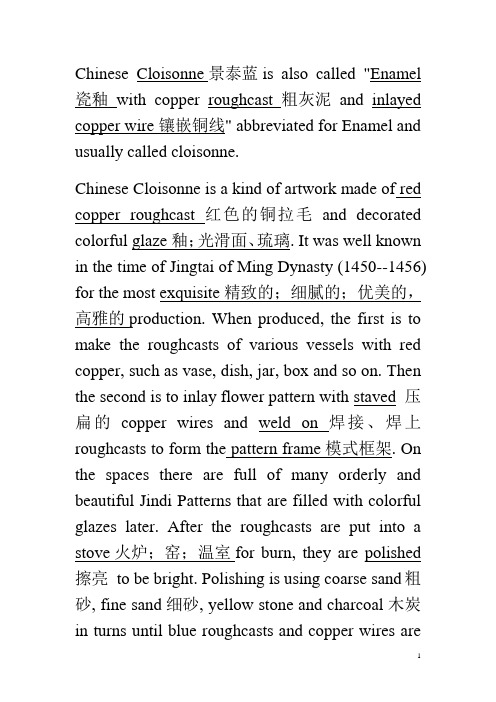
Chinese Cloisonne景泰蓝is also called "Enamel 瓷釉with copper roughcast粗灰泥and inlayed copper wire镶嵌铜线" abbreviated for Enamel and usually called cloisonne.Chinese Cloisonne is a kind of artwork made of red copper roughcast 红色的铜拉毛and decorated colorful glaze釉;光滑面、琉璃. It was well known in the time of Jingtai of Ming Dynasty (1450--1456) for the most exquisite精致的;细腻的;优美的,高雅的production. When produced, the first is to make the roughcasts of various vessels with red copper, such as vase, dish, jar, box and so on. Then the second is to inlay flower pattern with staved 压扁的copper wires and weld on焊接、焊上roughcasts to form the pattern frame模式框架. On the spaces there are full of many orderly and beautiful Jindi Patterns that are filled with colorful glazes later. After the roughcasts are put into a stove火炉;窑;温室for burn, they are polished 擦亮to be bright. Polishing is using coarse sand粗砂, fine sand细砂, yellow stone and charcoal木炭in turns until blue roughcasts and copper wires areclean and smooth. The last is to increase the luster 光泽、光彩, protect against rust生锈and then plate gold镀金and reach the effect of brilliance and effulgence光辉、灿烂、光泽.Its artistic feature is all of its style, pattern, color and brightness are very wonderful. It has a great deal of types. Most of them are daily vessels. Their styles are often grant and elegant. The patterns are very rich. Taking the traditional artistic skills of needlework, jade, china and lacquerwork漆器, it gives prominence突出;显著;隆起to the pattern style of sketching lines 勾画线条and filling colors. The color of glaze琉璃、釉includes blue, red, yellow, green, white, sky blue, navy blue海军蓝, carmine洋红, dark yellow暗黄色, light yellow淡黄色, light green亮绿色, milk white奶白色, deep violet深紫色, bright blue 明亮的蓝色and amaranth紫红色, etc... Caved gold and rich colors are so magnificent and luxuriant宏伟华丽.Cloisonne is a famous traditional enamel ware, known as the "Blue of Jingtai" in China, with ahistory of over 500 years. It was so called "blue" was the typical colour used for enamelling and "Jingtai" was the reign title of the 7th Ming Emperor. Enamel ware became very popular during the Emperor’s reign. There is a great variety of products, such as vase, jar, bowl, plate, box and ash-tray. They are brilliant in colours and splendid in design.Cloisonne is one of the famous arts and crafts工艺品,手艺of Beijing. The making of cloisonnérequires rather elaborate精心制作的;详尽的;煞费苦心的and complicated processes; base-hammering细扁铜丝做线条, copper-strip inlay铜丝镶嵌, soldering焊接, enamel-filling, enamel-firing, polishing抛光and gilding 贴金. The products are featured by excellent quality. The skill and workmanship have been handed down from the Ming Dynasty. Quite a number of new varieties have been created. It enjoys a high reputation both at home and abroad.CLOISONNE-MAKINGThe first step is body making. The material used for making the body is copper, because copper is easily hammered and stretched. This step requires a sound judgement in shaping and uniformity of thickness and weight. It is in fact the work of the copper smith. The only difference is that when an article is well shaped, the copper smith’s work is finished, whereas the cloisonnécraftsman’s work is just on the the start. The second step is filigree金银丝细工;金银丝工艺品soldering. This step requires great care and high creativeness. The artisan adheres使粘附copper strips onto the body. These strips are of 1/16 inch in diameter直径and of lengths as the artisan desires. The strips or filigree thus adhered make up a complicated but complete pattern. The artisan has a blueprint in mind and he can make full use of his experience, imagination and aesthetic审美的view in setting the copper strips on the body. The third step is to apply the colour which is known as enamel filling. The color or enamel is like the glaze on ceramics陶瓷. It is called falang. Its basic elements are boric acid硼酸,saltpeter and alkaline硝甲酸和碱性. Due to the difference in the minerals added, the color differs accordingly. Usually one with much iron will turn grey, with uranium铀, yellow, with chromium, green, with zinc, white, with bronze, blue, with gold or iodine, red. In time of filling, all the colors, ground beforehand into minute powder and contained in plates, are placed in front of the workers and are then applied to the little compartments separated by filigree. The fourth step is enamel firing. This is done by putting the article, with its enamel fillings, to the crucible. After a short moment, the copper body will turn red. But after firing, the enamel in the little compartment will sink down a bit. That will require a refilling. This process will go on repeatedly until the little compartments are finally filled. The fifth step is polishing.The first polish is with energy. Its aim is to make the filigree and the filled compartments even. The whole piece is again put to fire. Polish once more with a whet stone. Finally, use a piece of hard carbon to polish again so as toobtain some luster on the surface of the article. The sixth step is gilding. This is done by placing the article in fluid of gold or silver. Add electric current. The exposed parts of the filigree and the metal fringes of the article will be smoothly and evenly gilded. After that, the metal part of the article will not get rusty. Then the article will again undergo another electroplating and a slight polish.Cloisonne is one of the most famous crafts originated in Beijing. The existent and original ones are the produced in Yuan Dynasty with a history of thousands of years .The originals are mostly the imitations of the ancient bronze . The most delicate ones are the traditional handicraft of enamelware created more than 500 years ago during the Emperor Xuan De’s reign (1426-1435) in the Ming Dynasty.When it comes to the Jingtai period of the Ming Dynasty(1450-1456), the technologists found a new color material of deep blue which made the craft more elegant and noble, calm andbountiful. Later this kind of enamelware is known as “JingtaiBlue”in Chinese and used in today. Jingtai actually is the name of the 7th Emperor in the Ming Dynasty.The enameling has not changed , but the copper material has developed quickly. The Jingtai craft reached its climax in Qinglong period of Qing Dynasty by using the good flexible copper.Cloisonne is also called enamelware which is a special craft combined copper with porcelain. Cloisonne-making requires rather complicated process and the skill and the workmanship of cloisonne-making have been handed down from the Ming Dynasty. It greatly gathered the bronze craft and the porcelain craft, as well as the painting and carving craft of the Chinese traditional craft.Beijing is the cradle of cloisonne technique. The earliest and existing cloisonne is the product in Yuan dynasty, which we know it has nearly thousands-year history already. The original cloisonne were most of the archaized bronze ware,especially produced during the Xuande period of Ming dynasty is fine.During the course of Jingtai period of Ming that is between 1450 and 1456 craftsmen found a blue glaze in navy-blue color which is elegant and decent of the artworks. That is the cloisonne we are using now.From then on, it seemed no any great breakthrough instead of the rapid development of using the coppery material, which used a pure coppery with better extension. Thus, the cloisonne technique arrived the crest.Cloisonne has another name inlaid enamel which is the unique technique of the combination of porcelain and bronze. When doing the cloisonne, firstly, use the red coppery to make the body, secondly, stick the pattern on the bronze body by oblate and thin brass wires, then fill the inlay pattern by enamel glaze material in different colors, the last procedure is the firing over and over, polishing and gilding. We may say, the technique of cloisonne is used not only the bronze crafts, butalso the porcelain crafts, meanwhile, fetching in plenty of traditional and carving technique, which is the combination of Chinese traditional arts.。
明清景泰蓝

10铜胎掐丝珐 1
琅仰覆莲花圆 盒
11铜胎掐丝珐 2
琅仿青铜器出 戟尊一对
3 12铜胎掐丝珐
琅直颈瓶一对
4 13铜胎掐丝珐
琅蒜头瓶一对
5 14铜胎掐丝珐
琅出戟尊一对
15铜胎掐丝珐琅净水 匜
16铜胎掐丝珐琅香炉
17铜胎掐丝珐琅执壶
18铜胎掐丝珐琅三足 香炉
19铜胎掐丝珐 1
琅大鼎
20铜胎掐丝珐 2
琅长方盒
53铜胎掐丝珐 2
琅嵌玉钉双龙 耳簋式炉
3 54铜胎掐丝珐
琅琮
4 55铜胎掐丝珐
琅嵌宝石八卦 琮
5 56铜胎掐丝珐
琅四彩小杯五 只
57铜胎掐丝珐琅三阳 开泰尊一对
58铜胎掐丝珐琅帽架 一对
59铜胎掐丝珐琅文房 一套
60铜胎掐丝珐琅水丞
61铜胎掐丝珐琅鼎式 炉
62铜胎掐丝珐琅画轴 形多宝格
44铜胎掐丝珐琅缠枝 纹甘露瓶一对
45铜胎掐丝珐琅多穆 壶一对
0 1
46铜胎掐 丝珐琅莲花 香熏一对
0 2
47铜胎掐 丝珐琅绶带 葫芦瓶一对
0 3
48铜胎掐 丝珐琅书卷 式小几
0 4
49铜胎掐 丝珐琅配饰 青金石鹿摆 件一对
0 6
51铜胎掐 丝珐琅桃形 笔洗
0 5
50铜胎掐 丝珐琅砚盒
52铜胎掐丝珐 1
作者介绍
这是《明清景泰蓝》的读书笔记模板,暂无该书作者的介绍。
读书笔记
这是《明清景泰蓝》的读书笔记模板,可以替换为自己的心得。
精彩摘录
这是《明清景泰蓝》的读书笔记模板,可以替换为自己的精彩内容摘录。
谢谢观看
琅盘龙蒜头瓶 一对
2019-景泰蓝导游词word版本 (15页)

本文部分内容来自网络整理,本司不为其真实性负责,如有异议或侵权请及时联系,本司将立即删除!== 本文为word格式,下载后可方便编辑和修改! ==景泰蓝导游词篇一:景泰蓝导游词Cloisonne is a famous traditional enamel ware, known as the "Blue of Jingtai" in China, with a history of over 500 years. it was so called "blue" was the typical colour used for enamelling and "Jingtai" was the reign title of the 7th Ming Emperor. Enamel ware became very popular during the Emperor's reign. There is a great variety of products, such as vase, jar, bowl,plate, box and ash-tray. They are brilliant in colours and splendid in design.Cloisonne is one of the famous arts and crafts of Beijing. The making of cloisonne requires rather elaborate and complicated processes; base-hammering, copper-strip inlay, soldering, enamel-filling, enamel-firing, polishing and gilding. The products are featured by excellent quality. The skill and workmanship have been handed down from the Ming Dynasty. Quite a number of new varieties have been created. it enjoys a high reputation both at home and abroad. They are mostly for export.CLOISONNE-MAKINGThe first step is body making. The material used for making the bodyis copper, because copper is easily hammered and stretched. This step requires a sound judgement in shaping and uniformity of thickness and weight. It is in fact the work of the copper smith. The only difference is that when an article is well shaped, the copper smith‘s work is finished, whereas the cloisonne craftsman’s work is just on the the start.The second step is filigree soldering. This step requires great care and high creativeness. The artisan adheres copper strips onto the body. These strips are of 1/16 inch in diameter and of lengths as the artisan desires. The strips or filigree thus adhered make up a complicated but complete pattern. The artisan has a blueprint in mind and he can make full use of his experience, imagination and aesthetic view in setting the copper strips on the body.The third step is to apply the colour which is known as enamelfilling. The colour or enamel is like the glaze on ceramics. It is called falang. Its basic elements are boric acid, saltpetre and alkaline. Dueto the difference in the minerals added, the colour differs accordingly. Usually one with much iron will turn grey, with uranium, yellow, with chromium, green, with zinc, white, with bronze, blue,with gold or iodine, red. In time of filling, all the colours, ground beforehand into minute powder and contained in plates, are placed in front of the workers and are then applied to the little compartments separated by filigree.The fourth step is enamel firing. This is done by putting the article, with its enamel fillings, to the crucible. After a short moment, the copper body will turn red. But after firing, the enamel in the little compartment will sink down a bit. That will require a refilling. This process will go on repeatedly until the little compartments arefinally filled.The fifth step is polishing. The first polish is with energy. Its aim is to make the filigree and the filled compartments even. The whole piece is again put to fire. Polish once more with a whet stone. Finally, use a piece of hard carbon to polish again so as to obtain some lustre on the surface of the article.The sixth step is gilding. This is done by placing the article influid of gold or silver. Add electric current. The exposed parts of the filigree and the metal fringes of the article will be smoothlyand evenly gilded. After that, the metal part of the article will not get rusty. Then the article will again undergo another electroplating and a slight polish.篇二:[外语导游词]景泰蓝英文导游辞; Cloisonne is a famous traditional enamel ware, known as the "Blueof Jingtai" in China, with a history of over 500 years. it was so called "blue" was the typical colour used for enamelling and "Jingtai" was the reign title of the 7th Ming Emperor. Enamel ware became very popular during the Emperor's reign. There is a great variety of products, such as vase, jar, bowl,plate, box and ash-tray. They are brilliant in colours and splendid in design.????Cloisonne is one of the famous arts and crafts of Beijing.The making of cloisonne requires rather elaborate and complicated processes; base-hammering, copper-strip inlay, soldering, enamel-filling, enamel-firing,polishing and gilding. The products are featured by excellent quality. The skill and workmanship have been handed down from the Ming Dynasty. Quite a number of new varieties have been created. it enjoys a high reputation both at home and abroad. They are mostly for export.????CLOISONNE-MAKING????The first step is body making. The material used for making the bodyis copper, because copper is easily hammered and stretched. This step requires a sound judgement in shaping and uniformity ofthickness and weight. It is in fact the work of the copper smith. The only difference is that when an article is well shaped, the copper smith??s work is finished, whereas th e cloisonne craftsman?ˉs workis just on the the start.????The second step is filigree soldering. This step requires great care and high creativeness. The artisan adheres copper strips ontothe body. These strips are of 1/16 inch in diameter and of lengths as the artisan desires. The strips or filigree thus adhered make up a complicated but complete pattern. The artisan has a blueprint in mind and he can make full use of his experience, imagination and aesthetic view in setting the copper strips on the body.????The third step is to apply the colour which is known as enamel filling. The colour or enamel is like the glaze on ceramics. It is called falang. Its basic elements are boric acid, saltpetre and alkaline. Due to the difference in the minerals added, the colour differs accordingly. Usually one with much iron will turn grey, with uranium, yellow, with chromium, green, with zinc, white, with bronze, blue, with gold or iodine, red. In time of filling, all the colours, ground beforehand into minute powder and contained in plates, are placed in front of the workers and are then applied to the little compartments separated by filigree. ????The fourth step is enamel firing. This is done by putting the article, with its enamel fillings, to the crucible. After a short moment, the copper body will turn red. But after firing, the enamel in the little compartment will sink down a bit. That will require a refilling. This process will go on repeatedly until the little compartments are finally filled.????The fifth step is polishing. The first polish is with energy. Its aim is to make the filigree and the filled compartments even. The whole piece is again put to fire. Polish once more with a whet stone. Finally, use a piece of hard carbon to polish again so as to obtain some lustre on the surface of the article.????The sixth step is gilding. This is done by placing the article in fluid of gold or silver. Add electric current. The exposed parts of the filigree and the metal fringes of the article will be smoothlyand evenly gilded. After that, the metal part of the article will not get rusty. Then the article will again undergo another electroplating and a slight polish.篇三:北京导游词北京导游词大家好,大家有来过北京的吗?感觉北京的天气怎么样?北京的天气冷不冷不是看外面出不出太阳,看什么呢?看风!只要吹风,天气就会比较冷。
英语六级高分作文—景泰蓝(CLOISONNE)
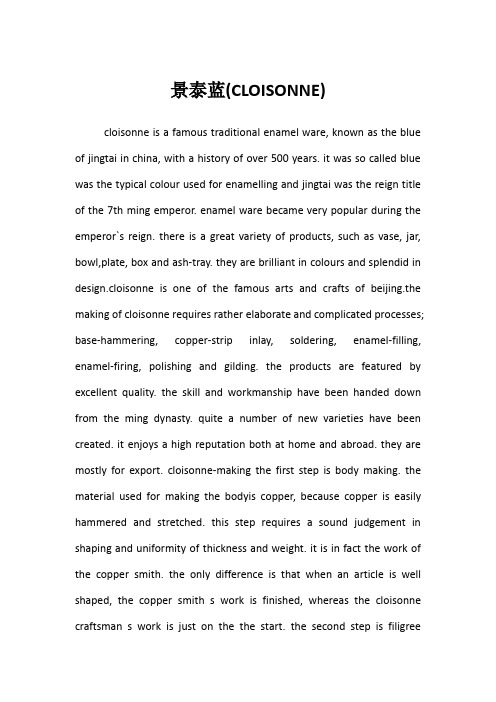
景泰蓝(CLOISONNE)cloisonne is a famous traditional enamel ware, known as the blue of jingtai in china, with a history of over 500 years. it was so called blue was the typical colour used for enamelling and jingtai was the reign title of the 7th ming emperor. enamel ware became very popular during the emperor`s reign. there is a great variety of products, such as vase, jar, bowl,plate, box and ash-tray. they are brilliant in colours and splendid in design.cloisonne is one of the famous arts and crafts of beijing.the making of cloisonne requires rather elaborate and complicated processes; base-hammering, copper-strip inlay, soldering, enamel-filling, enamel-firing, polishing and gilding. the products are featured by excellent quality. the skill and workmanship have been handed down from the ming dynasty. quite a number of new varieties have been created. it enjoys a high reputation both at home and abroad. they are mostly for export. cloisonne-making the first step is body making. the material used for making the bodyis copper, because copper is easily hammered and stretched. this step requires a sound judgement in shaping and uniformity of thickness and weight. it is in fact the work of the copper smith. the only difference is that when an article is well shaped, the copper smith s work is finished, whereas the cloisonne craftsman s work is just on the the start. the second step is filigreesoldering. this step requires great care and high creativeness. the artisan adheres copper strips onto the body. these strips are of 1/16 inch in diameter and of lengths as the artisan desires. the strips or filigree thus adhered make up a complicated but complete pattern. the artisan has a blueprint in mind and he can make 第1 页。
景泰蓝英文导游词

Introduction to CloisonneCloisonne, also known as Jing Tai Lan (景泰蓝) in Chinese, is a unique form of art that involves the use of enameling technique on metal to create intricate patterns and designs. This technique is believed to have originated in ancient Egypt, but it was the Chinese who refined and perfected it.The name “Cloisonne” comes from the French word “cloison,” which means partition. The technique involves creating partitions on a metal surface using wires or strips of metal. These partitions are then filled with enamel, which is a colored glass substance that is fired at high temperatures to create a smooth and hard surface. This results in a stunning and durable piece of art.History of CloisonneCloisonne has a rich history that dates back to the 14th century in China. During the Ming dynasty, the technique became popular and was used to create beautifully crafted pieces of art that were highly valued. The Qing dynasty further refined the craft, with the imperial court demanding exquisite pieces of Cloisonne for their collections.The process of making Cloisonne was a closely guarded secret for centuries, with only a small group of artisans possessing the knowledge and skills to create these masterpieces. Today, the technique is still used by skilled artisans in China and around the world.Creating a Cloisonne PieceCreating a Cloisonne piece is a complex and time-consuming process that involves many steps. Here are the basic steps involved:1.Preparation of the base: The base material for Cloisonne is usuallycopper, although silver and gold can also be used. The metal is polished andshaped into the desired form.2.Adding partitions: The next step involves adding wire or metal stripsto create a pattern or design. These partitions are usually made of copper or brass.3.Filling with enamel: After the partitions are in place, the enamel isapplied in different colors using a brush. This process is repeated until all of the partitions are filled.4.Firing: The piece is then fired in a kiln at high temperatures to meltand fuse the enamel. The firing process can take several hours to several days, depending on the size and complexity of the piece.5.Polishing: The piece is then polished to give it a smooth and glossyfinish.Famous Cloisonne PiecesThere are many famous Cloisonne pieces that are highly valued for their beauty and rarity. Here are some examples:1.The Xuande Tripod: This 15th-century Cloisonne tripod is highlyvalued for its intricate design and vibrant colors. It was created during the Ming dynasty and is now housed in the National Palace Museum in Taipei.2.The Qing Dynasty Palace Lantern: This impressive Cloisonne lanternwas created during the Qing dynasty for Emperor Qianlong. It features dragons and other mythical creatures and is now housed in the Palace Museum inBeijing.3.The Ming Dynasty Unicorn: This beautiful Cloisonne unicorn wascreated during the Ming dynasty and was originally used as a decoration for the imperial palace. It is now housed in the British Museum in London.ConclusionCloisonne is a unique and beautiful form of art that has been treasured for centuries. Its intricate designs and vibrant colors continue to captivate art lovers around the world. In China, it is regarded as a symbol of wealth, status, and culture. As a visitor to China, a Cloisonne piece can make for a great souvenir that will remind you of the country’s rich cultural heritage.。
珐琅彩英文介绍

清“康乾盛世”是中国历史上发展程度最高、最兴旺繁荣的时代,当时的帝王励精图治,完成了古代圣贤所订定的为政最高标准——国富而民庶。
康熙帝在位61年,集中精力孜孜求治,行“宽仁之政”,采取宽赋等系列政策措施,开创了中国封建社会的130多年的盛世。
国泰民安是艺术创作的基础。
康熙帝在位期间,积极发展社会生产,拓展与外界的联系,珐琅彩瓷正式在这样的盛世之下产生的。
康熙帝对珐琅彩瓷十分重视,在故宫养心殿设窑炉,亲自参与瓷器的烧制,在皇帝的亲历亲为的条件下,珐琅彩瓷器的制作技术也更臻于完美,使得珐琅彩以崭新的面貌在中国陶瓷史上翻开了史无前例的篇章。
珐琅彩瓷器作为清康乾盛世的秘制秘藏之物,无论在制作工艺上,还是在艺术格调上都反映了那个时代中外文化交流和中国瓷器艺术制作的辉煌成就。
珐琅彩亦称瓷胎画珐琅,是吸取了铜胎画珐琅的技法,在瓷质的胎上,用各种珐琅彩料描绘而成的一种新釉上彩瓷。
清康熙时,铜胎画珐琅技法被成功移植到瓷胎上,珐琅彩瓷由此诞生。
自诞生之时起,珐琅彩瓷的制作就不同于其他瓷器。
珐琅彩是在问世之初就由皇帝直接督办,选取景德镇御窑厂烧制的上好白瓷素胎,经宫廷画师出具样稿、绘画、填彩等工序之后,将其放入宫内窑炉由皇宫内“造办处”烧制,生产过程受皇室亲自监控及严谨审查。
珐琅彩细润的胎瓷、精致的画工、明艳的色彩,尽显皇室雍容华贵的风采;瓷、画、料都带着皇家气派,成为专供皇室御赏极名贵的一种宫廷御用瓷。
瓷胎画珐琅的创烧,与康熙皇帝对画珐琅的喜爱有密切关系。
其兴起于康熙年间,在乾隆末年没落,是“庶民弗得一窥”的御用品。
具有极高的文化价值和艺术价值。
著名古瓷专家叶佩兰女士对瓷胎珐琅彩做过如下评价“宫廷秘藏,制作不易,传世极少,难以估量其价格”。
据2012年拍卖年鉴记载,一件清乾隆蓝地珐琅彩双龙莲纹碗以人民币50,236,740.00元成交。
珐琅彩瓷的艺术价值及收藏价值正不断升高。
玉瓷珐琅彩是我公司经长期细酌研制而成,采用传统制作与现代科技相结合,将古代瓷胎珐琅彩艺术工艺、掐丝珐琅器艺术效果及书画艺术完美结合,应用到玉瓷装饰中。
景泰蓝名词解释

景泰蓝名词解释景泰蓝(Cloisonne),中国的著名特种金属工艺品类之一,到明代景泰年间这种工艺技术制作达到了最巅峰,制作出的工艺品最为精美而著名,故后人称这种金属器为“景泰蓝”。
景泰蓝正名“铜胎掐丝珐琅”,俗名“珐蓝”,又称“嵌珐琅”,是一种在铜质的胎型上,用柔软的扁铜丝,掐成各种花纹焊上,然后把珐琅质的色釉填充在花纹内烧制而成的器物。
因其在明朝景泰年间盛行,制作技艺比较成熟,使用的珐琅釉多以蓝色为主,故而得名“景泰蓝”。
2017年12月1日,《公共服务领域英文译写规范》正式实施,规定景泰蓝标准英文名为Cloisonne。
据此,中国元代后期已出现掐丝[1] 制品,应是顺理成章的事情,而且故宫博物院收藏的兽耳三环樽、勾莲鼎式炉、缠枝莲象耳炉等,应是我国元代晚期作品。
在《宋史·外国列传》中记载:“大食国”本波斯之别称。
“大食”,是宋、元时期中国对西亚阿拉伯地区的称谓。
有关专家根据史料分析,“铜胎掐丝珐琅”大约于13世纪末,由阿拉伯国家传入中国。
传入之初,被称作“大食窑器”、“鬼国窑器”和“佛郎嵌”。
1935年中华民国北平市政秘书处编辑的《旧都略》在谈到景泰蓝起源时,援引《陶说》写道:珐琅,在过去叫“佛郎”,又叫“发郎”、“发蓝”,产于“拂”。
唐书称拂即大秦。
大秦即中世纪罗马帝国。
据有关史料记载,13世纪下半叶,元蒙军队远征,横跨欧亚大陆入侵西亚,俘虏了大批有专业技能的工匠作为工奴输往后方,专为蒙古贵族生产豪华日用品。
此时,阿拉伯地区流行华丽的金属胎珐琅制品。
在这种情形下,烧造"大食窑器"的阿拉伯工匠带着烧造技术和主要原料来到中国。
中国有句很有哲理的老话,“他山之石,可以攻玉”,即使这种以金属为胎填敷珐琅釉料烧制而成的作品是舶来品,但在中华民族博大精深的艺术土壤上,也很快就融会了中华民族的传统风格,成为中国工艺美术史上一颗璀璨的明珠。
“景泰蓝”这个称谓最先见于清宫造办处档案。
景泰蓝英文导游词

景泰蓝英文导游词各位读友大家好,此文档由网络收集而来,欢迎您下载,谢谢Cloisonne is a famous traditional enamel ware, known as the “Blue of Jingtai” in China, with a history of over 500 years. it was so called “blue” was the typical colour used for enamelling and “Jingtai” was the reign title of the 7th Ming Emperor. Enamel ware became very popular during the Emperor’s reign. There is a great variety of products, such as vase, jar, bowl,plate, box and ash-tray. They are brilliant in colours and splendid in design.Cloisonne is one of the famous arts and crafts of making of cloisonne requires rather elaborate and complicated processes; base-hammering, copper-strip inlay, soldering, enamel-filling, enamel-firing, polishing and gilding. The products are featured by excellent quality. The skill and workmanship have beenhanded down from the Ming Dynasty. Quite a number of new varieties have been created. it enjoys a high reputation both at home and abroad. They are mostly for export.CLOISONNE-MAKINGThe first step is body making. The material used for making the bodyis copper, because copper is easily hammered and stretched. This step requires a sound judgement in shaping and uniformity of thickness and weight. It is in fact the work of the copper smith. The only difference is that when an article is well shaped, the copper smith ‘s work is finished, whereas the cloisonne craftsman’s work is just on the the start.The second step is filigree soldering. This step requires great care and high creativeness. The artisan adheres copper strips onto the body. These strips are of1/16 inch in diameter and of lengths as the artisan desires. The strips or filigree thus adhered make up a complicated but complete pattern. The artisan has a blueprint in mind and he can make full use of his experience, imagination and aesthetic view in setting the copper strips on the body.The third step is to apply the colour which is known as enamel filling. The colour or enamel is like th[1] [2] 下一页各位读友大家好,此文档由网络收集而来,欢迎您下载,谢谢。
- 1、下载文档前请自行甄别文档内容的完整性,平台不提供额外的编辑、内容补充、找答案等附加服务。
- 2、"仅部分预览"的文档,不可在线预览部分如存在完整性等问题,可反馈申请退款(可完整预览的文档不适用该条件!)。
- 3、如文档侵犯您的权益,请联系客服反馈,我们会尽快为您处理(人工客服工作时间:9:00-18:30)。
All the process of making cloisonné are by hand, are following these steps: design, padding making, thread weaving, drawing, burning, polishing and gilding ect.
Thank you!
Cloisonne Bracelet
Cloisonne Vase
Cloisonne Crafts
Cloisonne has been made in various stuffs in people’s daily life.
Other Stuffs
Summary
Cloisonne is the ancient working people's wisdom crystallization. In the history of yuan, Ming and qing dynasty,the intelligent and diligent artisans artists created the splendid cloisonne culture with their hands.After the founding of new China, the development of cloisonne, the change of the times has made great development.
Cloisonne
景泰蓝
Content
1.Introduction 2.The Process of making Cloisonne 3.Cloisonne Craftpicture 4.Cloisonne Bracelet 5.Cloisonne Vase 6.Cloisonne Crafts 7.Different Stuffs of Cloisonne 8.Summary
What’s the cloisonne?
Cloisonne,is also called enamel, originated in yuan dynasty, Ming JingTai years (1450-1456) is the most popular.Because of its color mainly blue,so the ancient called cloisonne enamel. Cloisonne is a kind of famous traditional handicrafts in China, with 600 years of history. lt sets the history, culture, art and unique traditional techniques. Its unique national style and the profound connotation made it well-known all over the nation.And it can made in different sorts of modelling.
制蓝
打 磨
镀 金
The closionne craftpicture
Cloisonne painting color embedded technology in China is a kind of highgrade household decoration with various elegant design.
